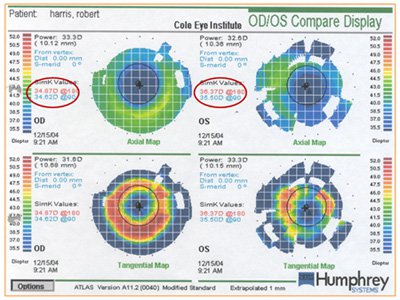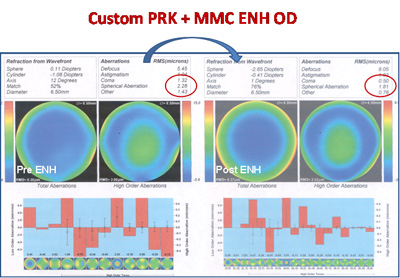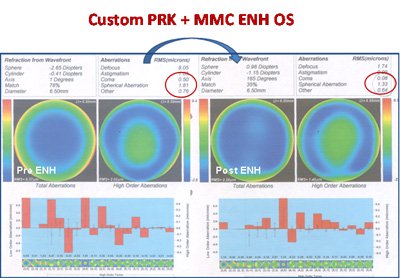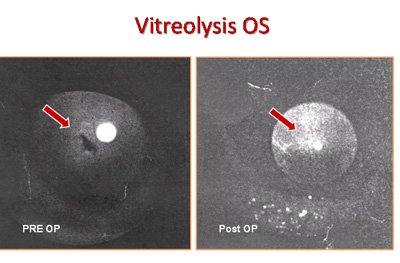Restoring Visual Quality with Customized Retreatment and Vitreolysis after High Myopic Laser Vision Correction
A 52-year-old white man with no significant history of systemic diseases presented for evaluation following a LASIK procedure 6 years prior for severe myopia (-13 D in both eyes). The patient’s refraction was -0.50 + 0.75 x 067 in the right eye and plano +1.00 x 135 in the left eye, with best spectacle-corrected visual acuity of 20/25 in both eyes and a dominant left eye. Photopic and mesopic pupil diameters were 4.0 mm and 6.0 mm, respectively. Keratometry was 34.62 x 34.87 at 180 in the right eye and 35.50 x 36.37 at 180 in the left eye (Slide 1). Central corneal thickness was 490 µm in the right eye and 488 µm in the left eye. A fundus examination revealed high myopia in both eyes. The patient reported halos, glare, ghost images and vertical diplopia. Wavefront analysis demonstrated significant coma and spherical aberration in both eyes (Slide 2 and Slide 3).
|
|
Custom-PRK enhancement was performed in both eyes with LADARVision 4000 followed by adjunctive MMC 0.02% application for 30 seconds, and copious irrigation with balanced salt solution. A bandage for contact lens was applied and predinsolone acetate 1%, ketorolac tromethamine 0.5%, and ciprofloxacin 0.3% were prescribed four times a day for one week. Predinsolone acetate 1% was tapered over the next 3 weeks. The preoperative and 3 months’ postoperative comparison of wavefront analysis maps showed significant improvement in the total high order aberrations root-mean-square, particularly in spherical aberration and coma (Slide 2 and Slide 3).
|
Although the uncorrected visual acuity was 20/20 after the custom-PRK enhancement, the patient reported a large floater in the left eye. The patient reported that the symptoms impaired his quality of vision and daily activities. Posterior vitreous detachment (PVD) and vitreous condensation covering the visual axis were observed on slit-lamp and fundus examination. No peripheral retinal tears or breaks were observed.
What is the clinical course of action for a patient reporting subjective improvement after the correction of aberrations, but noting impaired quality of vision from a prominent vitreous floater?
Clinical course of action:
The patient was evaluated by the retina specialist at our institution. The retina specialist contraindicated vitrectomy or any laser procedure to correct PVD.
The patient decided to consult another specialist. He underwent Nd:YAG laser vitreolysis to irradicate the floater. The vitreolysis Nd:YAG laser settings, as reported by the patient, were 2.6 mJ to 8.0 mJ, total of 177 shots, and 2 mm to 3.7 mm from the retina.
One month after the procedure, the patient returned for an evaluation. Slit-lamp examination showed intact cornea with no anterior chamber reaction, clear lens, no vitreous opacities, and flat retina with no peripheral tears (Slide 4). The patient revealed significant improvement of visual quality in the left eye and the floater (Sigmond) was gone.
|
Comments
Vitreolysis with Nd:YAG laser is not considered the standard of care, as vitreous condensations usually do not severely impair daily activities. This patient showed significant visual floaters that were managed with vitreolysis. The reported complications resulting from Nd:YAG laser vitreolysis include retinal detachment, direct retinal tear, vitreous strand traction, hemorrhage, cataract (adverse effect of intraocular shock), and IOP elevation. In this patient, the high energy of a Nd:YAG laser was effective. As a future alternative, we believe that transcorneally delivered femtosecond laser light could be effective and safe in separating or cutting the vitreous and be useful in the treatment of vitreoretinal pathologies, including symptomatic floaters. The precise delivery of the focused laser energy might be guided by adaptive optics technology to refine the spot placement and avoid damage of the adjacent retinal structures.
Bibliography
- Gandhi JS. Nd:YAG vitreolysis as a treatment for vitreous floaters. Eye. 2003; 17:113.
- Fankhauser F, Kwasniewska S. laser vitreolysis. A review. Ophthalmologica. 2002; 216:73-84.
- Delaney YM, Oyinloye A, Benjamin L. Nd:YAG vitreolysis and pars plana vitrectomy: surgical treatment for vitreous floaters. Eye. 2002; 16:21-26.
- Vandorselaer T, Van De Velde F, Tassignon MJ. Eligibility criteria for Nd-YAG laser treatment of highly symptomatic vitreous floaters. Bull Soc Belge Ophtalmol. 2001; 280:15-19.
- Benhamou N, Glacet-Bernard A, Le Mer Y, et al. Retinal detachment following YAG laser section of vitreous strands. A propos of 3 cases. J Fr Ophtalmol. 1998; 21:495-500.
- Vogel A, Capon MR, Asiyo-Vogel MN, Birngruber R. Intraocular photodisruption with picosecond and nanosecond laser pulses: Tissue effects in cornea, lens, and retina. Invest Ophthalmol Vis Sci. 1994; 35:3032-3044.
- Liu XY, Nie AG. Q-switched Nd:YAG laser surgery on vitreous traction bands. Zhonghua Yan Ke Za Zhi .1991; 27:182-184. Chinese.
- Reibaldi A, Spampinato D, Cavaliere S, et al. Effects of Nd-Yag laser vitreolysis on lens and vitreous prostaglandins in the rabbit eye. Metab Pediatr Syst Ophthalmol. 1991; 14:44-46.
- Gao YB. Vitreolysis with Nd:YAG laser. Zhonghua Yan Ke Za Zhi. 1990; 26:352-354. Chinese.
- Jagger JD, Hamilton AM, Polkinghorne P. Q-switched neodymium YAG laser vitreolysis in the therapy of posterior segment disease. Graefes Arch Clin Exp Ophthalmol. 1990; 228:222-225.
- Levy JH, Pisacano AM. Clinical experience with Nd:YAG laser vitreolysis in the anterior segment. J Cataract Refract Surg. 1987; 13:548-550.
- Hrisomalos NF, Jampol LM, Moriarty BJ, et al. Neodymium-YAG laser vitreolysis in sickle cell retinopathy. Arch Ophthalmol. 1987; 105:1087-1091.
- Little HL, Jack RL. Q-switched neodymium: YAG laser surgery of the vitreous. Graefes Arch Clin Exp Ophthalmol. 1986; 224:240-246.




